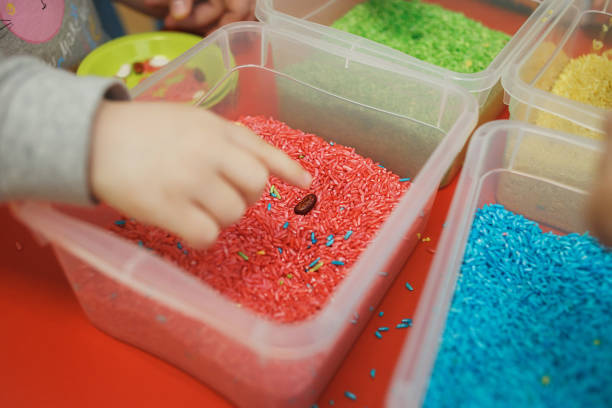Studies with Montessori Sensory Materials
Activity Name: Cylinder blocks.
Age group: 2.5+
Learning Outcomes and Indicators: Recognizing and arranging the existence of different dimensions visually. Fine motor development. Use of fingers to write. Purposeful movement. hand eye coordination. Preliminary preparation for mathematics (to make a series of 10).
Learning Process: The educator goes with the child to the cabinet with the cylinder blocks. Holds the two sides of the blocks (the hollow parts) firmly with both hands and brings them to the table.
While the cylinders are being removed, the child is offered an offer by saying: “I want to work with you with cylinder blocks today.” B cylinder block is brought with the accepting child. It is placed on the table with the part with the thick cylinder to the left. The trainer first grabs the top cylinder on the left with three fingers of the right hand and slowly removes it. So the child sees the material growing and the depth of the underside. He puts the exiting cylinder in front of the block and looks where the cylinder exits. Then he slowly pulls out the farthest cylinder on the right, puts it next to the cylinder he removed, and looks at where the cylinder came out. Then, starting from the left side, the 2nd, 3rd and other cylinders are removed and placed on the table. They look at their place. At each stage, eye contact is established with the child.
When installing rollers: The leftmost roller is taken. It is turned and examined by holding it with the right hand. A suitable cavity is searched for and inserted with the right hand. Then the rightmost one is taken, looked at and put in place. Starting from the left side again, all the cylinders are put in place in order. When the last two cylinders are left, they can be brought side by side to decide. When the work is finished, the child is offered to do it. It works the same with all cylinder blocks.
Children work with one cylinder block at a time and work the same way with all four sets. Cylinder blocks allow multiple children to work together at the same time. Children sit in fours around the table. First, each child puts the rollers in front of him on the table and the rollers are shuffled. Then the children try to find their own cylinders and place them in the appropriate places. The rollers have their own error checking. When the rollers do not fit into the appropriate compartment, the child realizes that there is a mistake and starts to see these indistinguishable differences in further exercises. Initially, work begins with block B. Thickness and thinness are given with this block. The size difference is one. Only the diameters change. Secondly, it is worked with the C block. In this block, 2 dimensions differ. As the diameters change, the directly proportional height changes. The concept of big and small is given. Third, working with the D block. Deep and shallow concepts can be given on this block. Low-high concepts are given with their cylinders. Finally, block A is taught. Only the size (depth) of the cylinders in this block differs. Other features are the same. Long-short and low-high concepts can be given. The trainer and student together hold the cylinder block properly and lift it into place. The blocks are placed in the cabinet from front to back in order of use.
Error Control: Error control is on the material. Cylinder not seated properly.
Material: Cylinder blocks with four different specifications. It consists of four block-like containers of the same size and shape (55 cm long, 5 cm high and 8 cm wide) made of natural-coloured wood. It has ten cylinders that can be easily inserted and removed thanks to the handle on each of the appropriate holes. The sizes of cylinders of different sizes change at regular intervals.
Words and Concepts: Cylinder, block, insertion-removal, thick-thin.
Adaptation: It can be worked with magnetic roller. It is possible to work with a smaller number of cylinders. Children with intellectual disabilities may be allowed to do it by trial and error
